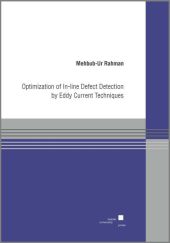 Neuerscheinungen 2011Stand: 2020-01-07 |
Schnellsuche
ISBN/Stichwort/Autor
|
Herderstraße 10
10625 Berlin
Tel.: 030 315 714 16
Fax 030 315 714 14
info@buchspektrum.de |

Mehbub-Ur Rahman
Optimization of In-line Defect Detection by Eddy Current Techniques
2011. VIII, 118 S. 21 cm
Verlag/Jahr: KASSEL UNIVERSITY PRESS 2011
ISBN: 3-86219-168-0 (3862191680)
Neue ISBN: 978-3-86219-168-0 (9783862191680)
Preis und Lieferzeit: Bitte klicken
This thesis presents innovative and advanced electromagnetic techniques for the in-line inspection of hot wire steel. The hot wire inspection procedure is performed with the eddy current (EC) sensor technique. Any type of crack on the upper surface of the steel wire disturbs the eddy current distribution which can be detected by the eddy current sensors. However, the eddy current distribution is only weakly influenced by cracks which are parallel to the wire, so-called longitudinal cracks. The conventional eddy current sensors cannot detect these cracks properly. To detect such longitudinal cracks a number of new EC sensors have been developed and successfully tested.
The modeling of the EC sensors and inspection techniques are numerically performed by setting up the governing equations for eddy current problems and then the dfferential, as well as the integral equations are solved with a suitable numerical method. A proper selection of the numerical technique plays an important role in successful simulation of the eddy current inspection procedure. Different numerical methods - the finite integration technique (FIT), the finite element method (FEM) and the boundary element method (BEM) are used to model this NDT (non-destructive testing) situation. The presented work is a part of the so-called INCOSTEEL project which is sponsored by the European Commission through the Research Fund for Coal and Steel (INCOSTEEL: In-line quality control of hot wire steel - Towards innovative contactless solutions and data fusion).
Every numerical method has its own advantages and disadvantages that need to be considered before using them to model a certain eddy current problem. FIT, FEM and BEM are discussed elaborately in this thesis for this purpose. A FIT based numerical tool MQSFIT is developed as a part of the scientific work. Two other simulation tools, based on FEM and BEM, along with MQSFIT, are used to model and optimize the eddy current sensors developed in INCOSTEEL project. However, the numerical results have to be validated against analytical and published results to prove the accuracy and reliability of the simulations. As a part of that, analytical solutions for a simple eddy current problem are discussed in the work. A comparison of all the numerical methods to the analytical solutions is also presented.
The numerical modeling, optimization and feedback modeling have met the demands of the INCOSTEEL project and thus led to the successful completion of the project in December 2008. The obtained results have opened the door for further future research and innovative ideas.


